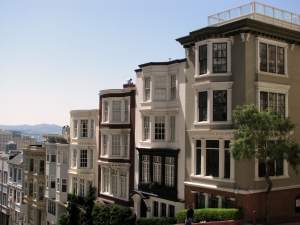BuildingRating.org is a hub for global activity in building energy rating and disclosure policy. Learn how energy rating works, compare local policies, and gain access to the resources you need to understand how rating and disclosure affects you. How can this site help you?
Policy Brief: San Francisco
 The San Francisco Board of Supervisors unanimously passed the Existing Commercial Buildings Energy Performance Ordinance in Feb. 2011. The ordinance requires annual benchmarking, periodic energy audits and the public disclosure of benchmarking information for nonresidential buildings. It augments a nonresidential benchmarking and disclosure law enacted by the state legislature in 2007.
The San Francisco Board of Supervisors unanimously passed the Existing Commercial Buildings Energy Performance Ordinance in Feb. 2011. The ordinance requires annual benchmarking, periodic energy audits and the public disclosure of benchmarking information for nonresidential buildings. It augments a nonresidential benchmarking and disclosure law enacted by the state legislature in 2007.
The ordinance is based on proposals by the Task Force on Existing Commercial Buildings, convened in 2009 by Mayor Gavin Newsome to develop and recommend actions to reduce energy consumption and carbon emissions, enhance electricity reliability and improve the competitiveness of commercial buildings in San Francisco. The Task Force included local commercial real estate owners, building operators, green building consultants, utilities and banks, and was advised by city and state policymakers.
The city's annual benchmarking requirement complements California's statewide initiative, AB 1103, requiring commercial buildings to disclose energy performance at point of transaction.
Key Provisions
San Francisco's ordinance stipulated the benchmarking of public and private (non-residential) buildings using Energy Star Portfolio Manager. Buildings must be over 10,000 SF to be subject to the requirement. The reported energy performance information will be disclosed via public website.
Non-residential buildings are to report benchmarking scores to the San Francisco Department of Environment (SFDOE) in the form of an Annual Energy Benchmark Summary. Compliance deadlines are staggered based on building size:
- October 1, 2011 for buildings 50,000 SF and greater;
- April 1, 2012 for buildings 25,000 to 49,999 SF;
- April 1, 2013 for those sized 10,000 to 24,999 SF.
Annual reporting of benchmarking scores will occur on April 1st each year after the initial reporting deadline. The very first AEBS score will not be disclosed publicly, so as to give owners a chance to understand the process and improve performance.
Document Library:
See all of our San Francisco-related documents here
Resources:
Existing Commercial Buildings Energy Performance Ordinance (2011)
Search And Map Menu
A rating evaluates the energy efficiency of a home or building. Disclosure is the process of publicizing this efficiency score. Such energy performance transparency informs the market about energy costs and encourages investments in efficiency. Learn more about Rating & Disclosure
Rating and Disclosure policies exist in more than 50 cities, states, and countries worldwide. This includes every EU member state, China, Australia, and jurisdictions across the United States. Check the global policy map
1707 L Street NW, Suite 1050 Washington DC 20036
© 2013 IMT All Rights Reserved. Read our Copyright and Permission requests information.
